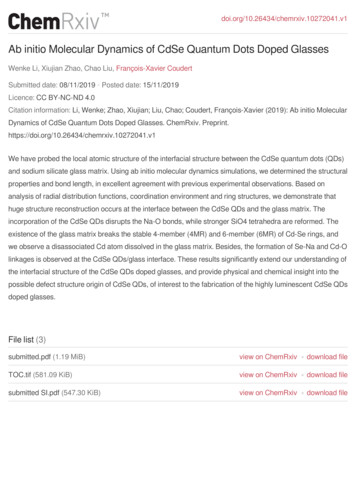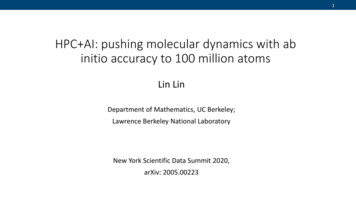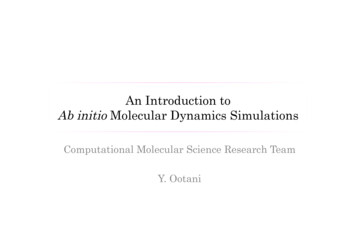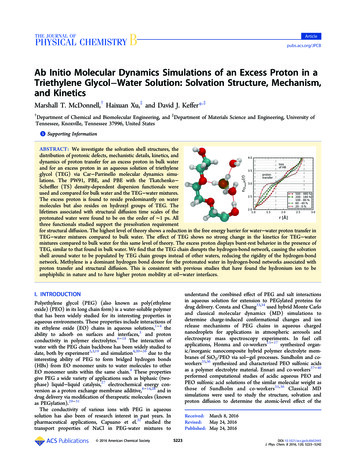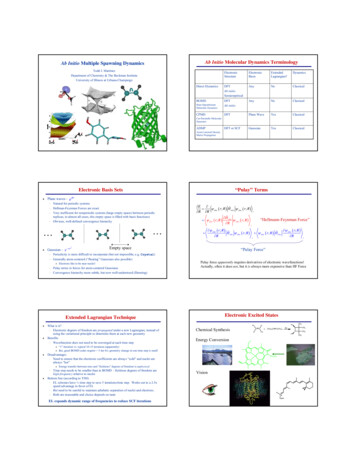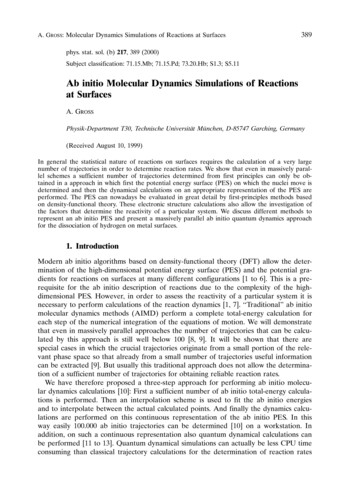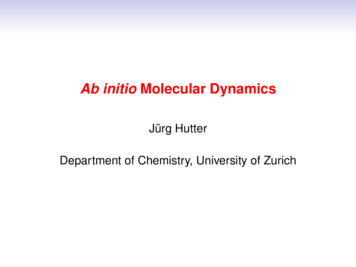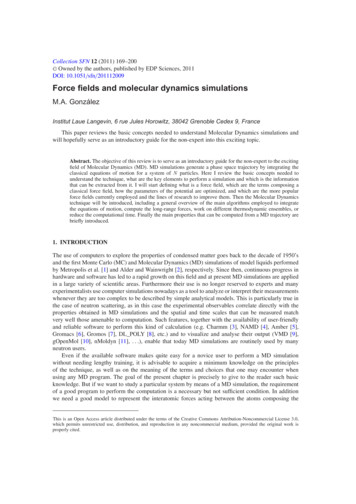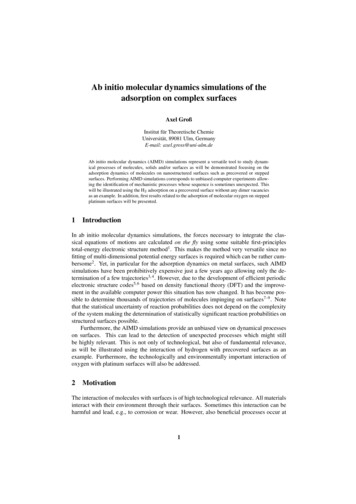
Transcription
Ab initio molecular dynamics simulations of theadsorption on complex surfacesAxel GroßInstitut für Theoretische ChemieUniversität, 89081 Ulm, GermanyE-mail: axel.gross@uni-ulm.deAb initio molecular dynamics (AIMD) simulations represent a versatile tool to study dynamical processes of molecules, solids and/or surfaces as will be demonstrated focusing on theadsorption dynamics of molecules on nanostructured surfaces such as precovered or steppedsurfaces. Performing AIMD simulations corresponds to unbiased computer experiments allowing the identification of mechanistic processes whose sequence is sometimes unexpected. Thiswill be illustrated using the H2 adsorption on a precovered surface without any dimer vacanciesas an example. In addition, first results related to the adsorption of molecular oxygen on steppedplatinum surfaces will be presented.1IntroductionIn ab initio molecular dynamics simulations, the forces necessary to integrate the classical equations of motions are calculated on the fly using some suitable first-principlestotal-energy electronic structure method1 . This makes the method very versatile since nofitting of multi-dimensional potential energy surfaces is required which can be rather cumbersome2 . Yet, in particular for the adsorption dynamics on metal surfaces, such AIMDsimulations have been prohibitively expensive just a few years ago allowing only the determination of a few trajectories3, 4 . However, due to the development of efficient periodicelectronic structure codes5, 6 based on density functional theory (DFT) and the improvement in the available computer power this situation has now changed. It has become possible to determine thousands of trajectories of molecules impinging on surfaces7–9 . Notethat the statistical uncertainty of reaction probabilities does not depend on the complexityof the system making the determination of statistically significant reaction probabilities onstructured surfaces possible.Furthermore, the AIMD simulations provide an unbiased view on dynamical processeson surfaces. This can lead to the detection of unexpected processes which might stillbe highly relevant. This is not only of technological, but also of fundamental relevance,as will be illustrated using the interaction of hydrogen with precovered surfaces as anexample. Furthermore, the technologically and environmentally important interaction ofoxygen with platinum surfaces will also be addressed.2MotivationThe interaction of molecules with surfaces is of high technological relevance. All materialsinteract with their environment through their surfaces. Sometimes this interaction can beharmful and lead, e.g., to corrosion or wear. However, also beneficial processes occur at1
surfaces. Many chemical reactions are considerably facilitated at catalytic surfaces. This isof particular interest considering the importance of (electro-)chemical energy storage andconversion for the future energy technology. In order to improve the chemical activity ofcatalysts, it is important to understand how reactions proceed on surfaces. For decades,surface science studies, both experimental and theoretical, have been extremely successfulin elucidating atomistic structures and processes on well-defined clean surfaces. Yet, manytechnologically relevant processes occur on precovered, structured surfaces. Therefore it iscrucial to take into account the full complexity when studying such processes on surfaces.3Computational MethodThe AIMD simulations have been performed using the periodic Vienna Ab initio Simulation Package (VASP)5 within the supercell approach. Electronic exchange and correlationhave been described within the generalized gradient approximation (GGA)10, 11 . The ioniccores have been represented either by ultrasoft pseudopotentials12, 13 or by projected augmented wave (PAW) potentials14, 15 . The convergence of the electronic structure calculations with respect to the energy cutoff representing the size of the plane-wave basis set andthe k-point sampling for the integration over the first Brillouin zone was carefully tested.The AIMD simulations were performed using the Verlet algorithm16 with a time stepof 1 fs within the microcanonical ensemble, i.e., the total energy was conserved duringthe simulations. This energy conservation was typically fulfilled to within 5 meV along aAIMD run. Sticking probabilities for each considered structure and incident kinetic energywere evaluated by averaging over 100 to 150 trajectories which were started with randominitial lateral positions and orientations of the impinging molecules far enoughabove thepsurface, The statistical error of the sticking probabilities amounts to σ S(1 S)/ Nwhere S is the sticking probability and N the number of trajectories17 . For N 150, thestatistical error is σ 0.04, and for N 100, σ 0.05 . Note that the statistical error doesnot depend on the complexity of the system, i.e., on the number of considered dynamicaldegrees of freedom, but only on the number of calculated trajectories.4Hydrogen adsorption on H-precovered Pd(100)The adsorption of H2 on Pd(100) represents one of the model systems in surface sciencefor the study of adsorption phenomena. In addition to its importance in hydrogenationreaction this system is also interesting because of the fact that palladium can absorb hugeamounts of hydrogen18 . Because of the high sticking probability of H2 on Pd(100)19 , thesurface becomes quickly covered by hydrogen once it is exposed to a H2 gas. In orderto model the adsorption of H2 on H-precovered Pd(100), we have used (2 2), (4 2),(3 2), and (3 3) unit cells with various amounts or preadsorbed hydrogen atoms. Notethat there are typically several different arrangements of the adsorbed hydrogen atoms fora given coverage unless the surface is fully covered.The results of more than 6,000 AIMD trajectory calculations with respect to the sticking probability at various hydrogen coverages are summarized in Fig. 1 where the stickingprobability of H2 on H-precovered Pd(100) is plotted as a function of the coverage. Thedifferent values of the sticking probability for the same hydrogen coverage are due to the2
Figure 1. Relative dissociative adsorption probability S(Θ)/S(0) of hydrogen on hydrogen-covered Pd(100) asa function of coverage. The theoretical results are obtained for an initial kinetic energy of 0.1 eV at different configurations of the adsorbed hydrogen atoms whereas the experimental results by by Behm et al.20 are measuredusing a H2 gas. In addition, a snapshot of an AIMD trajectory is shown for a hydrogen precoverage of ΘH 3/4in a 2 4 structure.fact that several arrangements of the pre-adsorbed hydrogen atoms were considered whichin general exhibit different sticking probabilities. In addition, the solid and the dashed linein Fig. 1 correspond to the sticking probability in the case of pure site-blocking withoutany dynamical effects if jut one or two empty sites, respectively, are required for the H2adsorption. The fact that the AIMD sticking probabilities are larger than the results forpure site-blocking indicates that there are important dynamical effects such as steering ordynamical trapping in the adsorption process which enhance the sticking probability.Experimental results20 are also included in Fig. 1. Note that the calculations havebeen done for a mono-energetic molecular beam with a initial kinetic energy of Ekin 0.1 eV whereas the experiment was performed with a H2 gas. Still it is satisfying that thetheoretical results trail the experimental ones.In addition, in Fig. 1 two curves S(Θ) S(0)(1 Θ) and S(Θ) S(0)(1 Θ)2are included which correspond to the sticking probability at a precovered surface if it isgoverned by pure site-blocking requiring one or two empty adsorption sites, respectively.The measured and most of the calculated sticking probabilities are above these two curvesindicating that there are steering and trapping effects that lead to a higher sticking probability than expected for pure site-blocking although there is some slight repulsive interactionbetween pre-adsorbed hydrogen atoms and the impinging hydrogen molecule, as DFT calculations show. Interestingly enough, for the adsorption of H2 on hydrogen-precoveredPd(111) both experimental and theoretical results find a dependence of the sticking probability on the coverage which is close to the S(Θ) S(0)(1 Θ)2 curve21 .This significant difference between Pd(100) and Pd(111) is related to the fact that onPd(100) the hydrogen atoms in the four-fold hollow adsorption site are located almost atthe same height as the surrounding Pd atoms whereas on Pd(111) the adsorbed hydrogenatoms in the smaller three-fold hollow sites are positioned higher above the Pd atoms.3
Figure 2. Calculated relative dissociative adsorption probability S(Θ)/S(0) of H2 impinging on hydrogencovered Pd(100) with a coverage of ΘH 1/2 and ΘH 2/3, respectively, with an initial kinetic energy ofEkin 0.1 eV for three different adsorbate structure within a (3 3) periodicity as indicated in the insets.In addition, the stability E in meV of the adsorbate structures per hydrogen atom with respect to the mostfavorable structure is given in the figure.Consequently, on Pd(100) the adsorbed hydrogen atoms are effectively shielded by the Pdatoms leading to a rather small mutual repulsion between the hydrogen atoms. On Pd(111),there is a stronger H-H repulsion which effectively leads to the much lower sticking probability than on Pd(100) at the same hydrogen coverage.The fact that there is still some admittedly small mutual hydrogen repulsion on Pd(100)is illustrated in Fig. 2 where for several hydrogen adsorbate structures their stability Eper hydrogen atom with respect to the most favorable structure is given. Typically, themore compact the H-adsorbate structures, i.e., the higher the number of nearest-neighborH atoms, the less stable the structure is. For the corresponding sticking probability of H2molecules impinging on these particular structures that is also plotted in Fig. 2, we find ananti-correlation with respect to the stability. The more compact H structures which as aconsequence also exhibit compact vacancy structures lead to higher sticking probabilities.Still, it is important to realize that also on substrates where there is no dimer vacancypresent, as for the most stable structures included in Fig. 2, still H2 dissociative adsorptionis possible. The dissociation starts with one H atom entering the four-fold hollow site withthe other H atom remaining at a neighboring bridge site. From there, it propagates in aexchange-like mechanism until it finds an empty hollow site.For one particular ΘH 1/2 structure within a 2 2 geometry, simulations with different subsets of substrate atoms kept fixed have been performed. The corresponding stickingprobabilities also plotted in Fig. 2 show that there is a strong dependence of the sticking probability on the recoil of the substrate atoms, much stronger than on flat surfaces7 .This again indicates the importance of dynamical effects in these strongly corrugated, nonactivated system.4
Figure 3. Left panel: Two-dimensional cut through the potential energy surface of H2 /S(2 2)/Pd(100) as afunction of the H-H distance and the H2 distance from the surface calculated by periodic DFT calculations. Theinset illustrates the molecular orientation and lateral center of mass position. The contour spacing is 0.1 eV. Rightpanel: Sticking probability determined in AIMD simulations for H2 impinging on S(2 2)- and Cl(2 2)-coveredPd(100). For Ekin 0.4 eV and H2 /S(2 2)/Pd(100), the AIMD result for a fixed substrate is also shown. Inaddition, the measured sticking probability of H2 on S-covered Pd(100)19 is included.5Hydrogen adsorption on S- and Cl-precovered Pd(100)Both the study of sulfur as well as chlorine co-adsorption is technologically relevant andinteresting. Sulfur is known as a poison for the car exhaust catalyst, and on Pd(100), itleads to a significant reduction of the hydrogen dissociation probability19, 22 . The specificadsorption of chlorine is a typical process occuring at electrochemical metal-electrolyteinterfaces. Whereas there is already some mutual repulsion between adsorbed hydrogenatoms, preadsorbed sulfur or chlorine atoms lead to much stronger repulsion, turning thenon-activated H2 adsorption on Pd(100) into an activated none, i.e., there are no longer anypaths without any barrier towards dissociative adsorption23 .The minimum barrier for H2 dissociation on S(2 2)/Pd(100) is illustrated Fig. 3where a two-dimensional cut through the potential energy surface is shown. Whereas theparticular path shown in Fig. 3 is non-activated on clean Pd(100)24 , it becomes hindered bya barrier of about 0.25 eV. In fact, chlorine adsorption has a rather similar effect as sulfuron the H2 -Pd(100) interaction, the barriers are just 50 meV smaller.Such a poisoning of the substrate of course also changes the adsorption dynamics significantly from non-activated to activated behavior, i.e., the sticking probability typicallyincreases monotonically with the incident kinetic energy, as Fig. 3 shows, where the results of AIMD simulations are also shown.The difference in the minimum barrier heightsbetween H2 /S(2 2)/Pd(100) and H2 /Cl(2 2)/Pd(100) are reflected in the correspondingshift between the sticking curves. Interestingly, keeping the substrate fixed modifies thesticking probability only to a small extent. Apparently for an activated system the recoil ofthe substrate atoms matters less than for a strongly corrugated non-activated system (seeFig. 2).Still, for H2 /S(2 2)/Pd(100) there is a large discrepancy between AIMD and exper-5
Figure 4. Snapshots of an AIMD trajectory of O2 impinging on Pt(211) with an initial kinetic energy of Ekin 0.1 eV.imental results. Although short-comings of DFT calculations can never be excluded, itshould be noted that experimentally the preparation of an ordered (2 2) sulfur overlayeron Pd(100) has not been fully confirmed19, 25 . Hence the discrepancy might be due todifferent sulfur overlayers realized in the calculations and in the experiment.6Interaction dynamics of O2 with stepped PtThe adsorption of O2 on Pt is one of the crucial steps occurring in the car exhaust catalyst.Since realistic catalysts do not correspond to low-index single crystal surfaces but ratherconsists of small particles with high step densities, it is important to clarify the role of stepsin catalytically important reactions. On Pt(111), direct O2 dissociation does not occur dueto steric hindrance26, 27 , but it is still unclear whether it might happen at stepped surfaceswhere the energy gain upon adsorption is much larger28 .From a technical point of view, DFT simulations including O2 are much more demanding than simulations involving H2 due to the fact that O2 is in the triplet state in the gasphase which requires a spin-polarized treatment. This does not only mean that twice asmany basis functions have to be taken into account for both the spin up and the spin downcomponents, but typically the convergence of the self-consistent field iteration to solve theKohn-Sham equations is much worse compared to spin-unpolarized calculations.Still, it is possible to run AIMD trajectories in the O2 /Pt(211) system. First preliminaryresults are shown in Fig. 4 where snapshots of a trajectory of O2 impinging on Pt(211)are depicted. After 350 fs, the O2 molecules hits the surface with one atom above thelower side of the step. Still, the O2 molecule is steered towards the upper side of thestep (T 790 fs) where the most favorable adsorption site is located. Here, the moleculebecomes molecularly trapped in the most favorable molecular adsorption site (T 4.4 ps)that has already been identified in DFT calculations28 .The AIMD simulations thus indicate that indeed steps do attract impinging O2molecules. Still, so far no dissociative adsorption event has been observed for O2 /Pt(211).Therefore it remains to be seen whether O2 dissociation on Pt(211) is a two-step processas on Pt(111)27 or whether it rather corresponds to a direct event.6
7Concluding RemarksThis study has illustrated that ab initio molecular dynamics studies are a powerful tool tostudy the adsorption of molecules on complex surface structures, such as precovered orstepped surfaces. The unbiased nature of the AIMD simulations allows important insightsinto the reaction dynamics on surfaces as long as several hundred trajectories are sufficientto obtain statistically meaningful results. Since the statistical error of the AIMD simulations with respect to the sticking probability does not depend on the complexity of theconsidered systems, AIMD simulations are also well-suited to address the adsorption dynamics of larger molecules such as e.g. small organic molecules. Simulations along theselines are planned for the future.AcknowledgmentsMany fruitful discussions with Fabio Busnengo and Ariel Lozano are gratefully acknowledged. The simulations presented in this work were made possible by a grant of computertime provided by the NIC of the Research Centre Jülich.References1. D. Marx and J. Hutter, Ab initio Molecular Dynamics: Theory and Implementation,in Modern Methods and Algorithms of Quantum Chemistry, edited by J. Grotendorst,volume 3 of NIC series, pages 329–477, John von Neumann-Institute for Computing,Jülich, 2000.2. S. Lorenz, M. Scheffler, and A. Groß, Descriptions of surface chemical reactionsusing a neural network representation, Phys. Rev. B 73, 115431 (2006).3. A. Groß, M. Bockstedte, and M. Scheffler, Ab initio molecular dynamics study of thedesorption of D2 from Si(100), Phys. Rev. Lett. 79, 701 (1997).4. L. C. Ciacchi and M. C. Payne, ”Hot-Atom” O2 Dissociation and Oxide Nucleationon Al(111), Phys. Rev. Lett. 92, 176104 (2004).5. G. Kresse and J. Furthmüller, Efficient iterative schemes for ab initio total-energycalculations using a plane-wave basis set, Phys. Rev. B 54, 11169 (1996).6. B. Hammer, L. B. Hansen, and J. K. Nørskov, Improved adsorption energetics withindensity-functional theory using revised Perdew-Burke-Ernzerhof functionals, Phys.Rev. B 59, 7413 (1999).7. A. Groß and A. Dianat, Hydrogen dissociation dynamics on precovered Pd surfaces:Langmuir is still right, Phys. Rev. Lett. 98, 206107 (2007).8. A. Groß, Ab initio molecular dynamics study of hot atom dynamics after dissociativeadsorption of H2 on Pd(100), Phys. Rev. Lett. 103, 246101 (2009).9. A. Groß, Ab initio molecular dynamics simulations of the adsorption of H2 on palladium surfaces, ChemPhysChem 11, 1374 (2010).10. J. P. Perdew, J. A. Chevary, S. H. Vosko, K. A. Jackson, M. R. Pederson, D. J. Singh,and C. Fiolhais, Atoms, molecules, solids, and surfaces: Applications of the generalized gradient approximation for exchange and correlation, Phys. Rev. B 46, 6671(1992).7
11. J. P. Perdew, K. Burke, and M. Ernzerhof, Generalized gradient approximation madesimple, Phys. Rev. Lett. 77, 3865 (1996).12. D. Vanderbilt, Soft self-consistent pseudopotentials in a generalized eigenvalue formalism, Phys. Rev. B 41, 7892 (1990).13. G. Kresse and J. Hafner, Norm-conserving and ultrasoft pseudopotentials for thefirst-row and transition elements, J. Phys.: Condens. Matter 6, 8245 (1994).14. P. E. Blöchl, Projector augmented-wave method, Phys. Rev. B 50, 17953 (1994).15. G. Kresse and D. Joubert, From ultrasoft pseudopotentials to the projector augmentedwave method, Phys. Rev. B 59, 1758 (1999).16. L. Verlet, Computer ”experiments” on classical fluids. I. Thermodynamical propertiesof Lennard-Jones molecules, Phys. Rev. 159, 98 (1967).17. P. M. Agrawal, A. N. A. Samadh, L. M. Raff, M. T. Hagan, S. T. Bukkapatnam,and R. Komanduri, Prediction of molecular-dynamics simulation results using feedforward neural networks: Reaction of a C2 dimer with an activated diamond(100)surface, J. Chem. Phys. 123, 224711 (2005).18. A. Pundt and R. Kirchheim, Hydrogen in metals: Microstructural aspects, Annu.Rev. Mater. Res. 36, 555–608 (2006).19. K. D. Rendulic, G. Anger, and A. Winkler, Wide range nozzle beam adsorption datafor the systems H2 /nickel and H2 /Pd(100), Surf. Sci. 208, 404 (1989).20. R. J. Behm, K. Christmann, G. Ertl, and M. A. Van Hove, Adsorption of CO onPd(100), J. Chem. Phys. 73, 2984 (1980).21. Y. Xiao and W. Dong, Molecular dynamics simulation of a complex surface reaction:The effect of coverage on H2 dissociation on Pd(111), Phys. Rev. B 83, 125418(2011).22. M. L. Burke and R. J. Madix, Hydrogen on Pd(100)-S: The effect of sulfur on precursor mediated adsorption and desorption, Surf. Sci. 237, 1 (1990).23. C. M. Wei, A. Groß, and M. Scheffler, Ab initio calculation of the potential energysurface for the dissociation of H2 on the sulfur-covered Pd(100) surface, Phys. Rev.B 57, 15572 (1998).24. S. Wilke and M. Scheffler, Potential-energy surface for H2 dissociation over Pd(100),Phys. Rev. B 53, 4926 (1996).25. M. Rutkowski, D. Wetzig, H. Zacharias, and A. Groß, Rotational and vibrationalpopulation of D2 desorbing from sulfur-covered Pd(100), Phys. Rev. B 66, 115405(2002).26. C. T. Rettner and C. B. Mullins, Dynamics of the chemisorption of O2 on Pt(111):dissociation via direct population of a molecularly chemisorbed precursor at highincidence kinetic-energy, J. Chem. Phys. 94, 1626 (1991).27. A. Groß, A. Eichler, J. Hafner, M. J. Mehl, and D. A. Papaconstantopoulos, Ab initiobased tight-binding molecular dynamics simulation of the sticking and scattering ofO2 /Pt(111), J. Chem. Phys. 124, 174713 (2006).28. P. Gambardella, Z̆. S̆ljivanc̆anin, B. Hammer, M. Blanc, K. Kuhnke, and K. Kern,Oxygen dissociation at Pt steps, Phys. Rev. Lett. 87, 056103 (2001).8
Ab initio molecular dynamics (AIMD) simulations represent a versatile tool to study dynam-ical processes of molecules, solids and/or surfaces as will be demonstrated focusing on the adsorption dynamics of molecules on nanostructured surfaces such as precovered or stepped surfaces. Performing AIMD simulations corresponds to unbiased computer experiments allow- ing the identification of .

